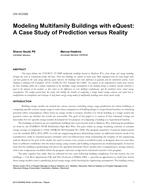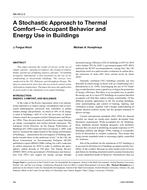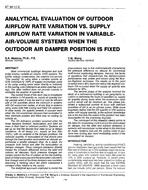Track: Systems and Equipment
Sponsor: 7.6 Building Energy Performance
Chair: Annie Smith, P.E., Associate Member, Ross & Baruzzini, St. Louis, MO
The industrial sector’s energy use is rising faster than energy reductions achieved in the residential and commercial sectors. Concurrently, more complex energy efficiency projects are implemented to save energy in industrial-scale and other large systems. Therefore, measurement and verification for industrial and other large systems is incredibly important to verify estimated energy and cost savings. However, this process can be very resource-intensive depending on the measurement and verification methodology. This seminar covers the methodologies available, how to properly measure energy savings in an industrial application and will touch on how valuable information can be obtained to identify additional savings opportunities.\
1. Measurement and Verification of Efficiency Upgrades in Chilled Water Systems
Abdul Qayyum “Q” Mohammed, Associate Member, Go Sustainable Energy, Columbus, OH
As the energy efficiency industry evolves, more complex efficiency projects like chilled water system upgrades, are being implemented which can get complicated and be resource-intensive. Two case studies are discussed in this presentation. A chilled water plant serving space-cooling loads and a chilled water system serving industrial process loads. The methodology being discussed allows the evaluator to meter the system for a reduced amount of time, observe an improvement in system efficiency and quantify the annual energy savings of the system, resulting in a streamlined process, reduced costs, better annual energy savings estimates and cost effective utility efficiency programs.
2. Adventures in Industrial Process Improvements
Dennis Landsberg, Ph.D., P.E., BEAP, Fellow Life Member, L&S Energy Services, Inc., Clifton Park, NY
Industrial energy use is growing faster than energy efficiency improvements being achieved in the residential and commercial sectors. Studies of industrial plants should include process as well as building improvements to find significant energy savings. Unlike other building types, industrial energy use is a function of production. To calculate savings and track performance, industrial energy consumption is divided into baseline usage and Btu/widget produced. This permits adjustment against variations in production over time and is required to apply for utility rebate programs to receive custom measure incentives. This presentation provides an overview of energy savings in some common industrial processes.
3. Measurement and Verification: Added Expense or Cheapest Energy Savings Available?
Chris Smith, P.E., Member, Energy 350, Portland, OR
The performance improvements of measurement and verification far exceed the cost, making it the most cost-effective portion of the project. M&V ensures the project is performing as expected, but also allows the implementer to gain more savings than originally anticipated or recovers savings that would have otherwise been lost. These incremental savings through combined commissioning and M&V can be harvested for a fraction of the cost of the initial savings. Using case studies and multiple real-world examples, this presentation quantifies and compares the cost of conducting combined commissioning and M&V to increase energy savings, producing the cheapest energy savings available.
Presented: Tuesday, January 23, 2018, 1:30 PM-3:00 PM
Run Time: 90 min.
This is a zip file that consists of PowerPoint slides synchronized with the audio-recording of the speaker (recorded presentation), PDF files of the slides, and audio only (mp3) for each presentation.
Citation: ASHRAE Seminar Recordings, 2018 Winter Conference, Chicago, IL
Product Details
- Published:
- 2018
- Units of Measure:
- Dual
- File Size:
- 1 file , 66 MB
- Product Code(s):
- D-CH18Sem48


